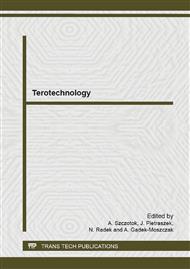[1]
D. Dubois, H. Prade, Operations on Fuzzy Numbers, Int. J. Syst. Sci. 9 (1978) 613-626.
Google Scholar
[2]
P. Grzegorzewski, Trapezoidal Approximation of Fuzzy Numbers Based on Sample Data, Comm. Com. Inf. Sc. 81 (2010) 402-411.
Google Scholar
[3]
R. Tyrala, Linear System with Fuzzy Solution, in: P. Grzegorzewski, (Ed. ), Issues in Soft Computing, Theory and Applications, EXIT Press, Warszawa (2005), 277-288.
Google Scholar
[4]
F. Campobasso, A. Fanizzi, Goodness of Fit Measures and Model Selection in a Fuzzy Least Squares Regression Analysis, Stud. Comput. Intell. 465 (2013) 241-257.
DOI: 10.1007/978-3-642-35638-4_16
Google Scholar
[5]
P. D'Urso, T. Gastaldi, An orderwise, polynomial regression procedure for fuzzy data, Fuzzy Set Syst. 130 (2002) 1-19.
DOI: 10.1016/s0165-0114(02)00055-6
Google Scholar
[6]
B. Gładysz, D. Kuchta, Polynomial Least Squares Fuzzy Regression Models for Temperature, in: A. Cader, (Ed. ), Artificial Intelligence and Soft Computing, EXIT Press, Warszawa (2006), 118-124.
Google Scholar
[7]
H.W. Kuhn, A.W. Tucker, Nonlinear programming, Proceedings of 2nd Berkeley Symposium. Berkeley, University of California Press (1951), 481-492.
Google Scholar
[8]
G.E.P. Box, N.R. Draper, Empirical Model-Building and Response Surface, John Wiley & Sons, Hoboken (1987).
Google Scholar
[9]
O. Kempthorne, K. Hinkelmann, Design and Analysis of Experiments. Vol. 1. Introduction to experimental design, John Wiley & Sons, Inc., Hoboken (1994).
Google Scholar
[10]
D.C. Montgomery, Design and Analysis of Experiments, John Wiley & Sons, Inc., Hoboken (2008).
Google Scholar
[11]
R.H. Myers, D.C. Montgomery, Response Surface Methodology. Process and Product Optimization Using Designed Experiments, John Wiley & Sons, Hoboken (1995).
Google Scholar
[12]
J. Pietraszek, Fuzzy Regression Compared to Classical Experimental Design in the Case of Flywheel Assembly, Lect. Notes Artif. Int. 7267 (2012) 310-317.
DOI: 10.1007/978-3-642-29347-4_36
Google Scholar
[13]
E. Skrzypczak-Pietraszek, A. Szewczyk, A. Piekoszewska, H. Ekiert, Biotransformation of hydroquinone to arbutin in plant in vitro cultures preliminary results, Acta Physiol. Plant. 27 (2005) 79-87.
DOI: 10.1007/s11738-005-0039-x
Google Scholar
[14]
B. Barrett, Medicinal properties of Echinacea: a critical review, Phytomedicine 10 (2003) 66-86.
DOI: 10.1078/094471103321648692
Google Scholar
[15]
J.B. Hudson, Applications of the Phytomedicine Echinacea purpurea (Purple Coneflower) in Infectious Diseases, J. Biomed. Biotechnol. (2012) DOI: 10. 1155/2012/769896.
DOI: 10.1155/2012/769896
Google Scholar
[16]
R. Schoop, P. Klein, A. Suter, S.L. Johnston, Echinacea in the prevention of induced rhinovirus colds: A meta-analysis, Clin. Ther. 28 (2006) 174-183.
DOI: 10.1016/j.clinthera.2006.02.001
Google Scholar
[17]
M.A. Baque, S.H. Moh, E.J. Lee, J.J. Zhong, K.Y. Paek, Production of biomass and useful compounds from adventitious roots of high-value added medicinal plants using bioreactor, Biotechnol. Adv. 30 (2012) 1255-1267.
DOI: 10.1016/j.biotechadv.2011.11.004
Google Scholar
[18]
E. Skrzypczak-Pietraszek, J. Pietraszek, Phenolic acids in in vitro cultures of Exacum affine Balf. f., Acta Biol. Cracov. Bot. 51 (2009) 62-62.
DOI: 10.18388/abp.2014_1922
Google Scholar
[19]
E. Skrzypczak-Pietraszek, A. Hensel, Polysaccharides from Melittis melissophyllum L. herb and callus, Pharmazie 55 (2000) 768-771.
Google Scholar
[20]
E. Skrzypczak-Pietraszek, J. Pietraszek, Chemical profile and seasonal variation of phenolic acid content in bastard balm (Melittis melissophyllum L., Lamiaceae), J. Pharmaceut. Biomed. 66 (2012) 154-161.
DOI: 10.1016/j.jpba.2012.03.037
Google Scholar
[21]
E. Skrzypczak-Pietraszek, J. Pietraszek, Application of fuzzy spread regression to analysis of biotechnological process efficiency, Studies and Proceedings of PAKM 42 (2011) 230-240.
Google Scholar


